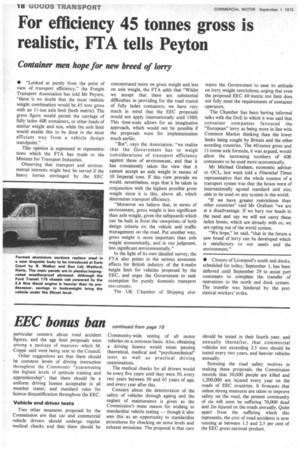For efficiency 45 tonnes gross is realistic, FTA tells Peyton
Page 20

If you've noticed an error in this article please click here to report it so we can fix it.
Container men hope for new breed of lorry
• "Looked at purely from the point of view of transport efficiency," the Freight Transport Association has told Mr Peyton, "there is no doubt that the most realistic weight combination would be 45 tons gross with an 11-ton axle limit (both metric). The gross figure would permit the carriage of fully laden 40ft containers, or other loads of similar weight and size, while the axle limit would enable this to be done in the most efficient way from a vehicle design standpoint."
This opinion is expressed in representations which the FTA has made to the Minister for Transport Industries.
Observing that transport and environmental interests might best be served if the heavy lorries envisaged by the EEC concentrated more on gross weight and less on axle weight, the FTA adds that "Whilst we accept that there are substantial difficulties in providing for the road transit of fully laden containers, we have very much in mind that the EEC proposals would not apply internationally until 1980. This time-scale allows for an imaginative approach, which would not be possible if the proposals were for implementation much earlier.
"But", says the Association, "we realize that the Government has to weigh considerations of transport efficiency against those of environment, and that it has consistently taken the view that it cannot accept an axle weight in excess of 10 Imperial tons. If this view prevails we would, nevertheless, urge that it be taken in conjunction with the highest possible gross weight since it is this, above all, which determines transport efficiency.
"Moreover we believe that, in terms of environment, gross weight is less significant than axle weight, given the safeguards which can be built in from the viewpoints of both design criteria on the vehicle and traffic management on the road. Put another way, gross weight is more important than axle weight economically, and in our judgment, less significant environmentally."
In the light of its own detailed survey, the FTA also points to the serious economic effects for British industry of the 4-meire height limit for vehicles proposed by the EEC, and urges the Government to seek exemption for purely domestic transport movements.
The UK Chamber of Shipping also wants the Government to ease its attitude on lorry weight restrictions, urging that even the proposed EEC 40 metric ton limit does not fully meet the requirements of container operators.
The Chamber has been having informal talks with the DoE in which it was said that container companies favoured the "European" lorry as being more in line with Common Market thinking than the lower limits being sought by Britain and the other acceding countries. The 40-tonne gross and 11-tonne axle formula, it was argued, would allow the increasing numbers of 40ftcontainers to be used more economically.
Mr Michael Graham, economic adviser to OCL, last week told a Financial Times representative that the whole essence of a transport systen was that the boxes were of internationally agreed standard and size, able to be used on any system in the world.
"If we have greater restrictions than other countries" said Mr Graham "we are at a disadvantage. If we bury our heads in the sand and say we will not carry these laden boxes, which are already with us, we are opting out of the world system.
"We hope," he said, "that in the future a new breed of lorry can be developed which is satisfactory to our needs and the environment."


































































































